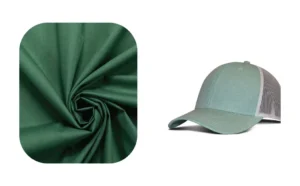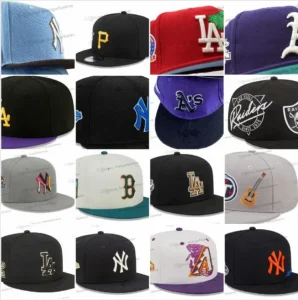Introduction
Producing hats that look good but harm the planet is no longer an option for eco-conscious brands. Traditional synthetic materials like polyester pile up in landfills, while unethical sourcing erodes consumer trust.
“Green hat manufacturing” offers a better way. By prioritizing organic cotton, recycled polyester, and ethical supply chains, brands like KINWIN create stylish, sustainable hats that align with eco-values. This guide dives into the materials, certifications, and practices driving sustainable hat production forward.
Introduction to Sustainable Hat Production
The fashion industry is changing fast, and sustainable hat production is leading the way. Consumers now want eco-friendly products, and brands are stepping up to meet this demand. This chapter explores why green hat manufacturing matters and how it’s shaping the future of fashion.
The Rise of Sustainable Fashion in Hat Manufacturing
Sustainable fashion is no longer a trend—it’s a movement. People are choosing hats made with eco-friendly hat materials because they care about the planet. Brands adopting green practices are gaining loyal customers who value ethics over fast fashion. This shift is pushing manufacturers to rethink how they design and produce hats.
Data shows that 66% of global consumers are willing to pay more for sustainable products, according to a 2023 Nielsen report. For hat makers, this means investing in green methods can boost both sales and reputation. It’s a “win-win” for businesses and the environment.
Environmental and Social Impacts of Traditional Hat Production
Traditional hat production can harm the planet. Processes like dyeing and tanning often use toxic chemicals that pollute water sources. Plus, low-wage factories raise ethical concerns about worker treatment. These issues make it clear why change is needed in the industry.
For example, cotton farming for hats uses about 7,000 liters of water per kilogram of fabric, per the World Resources Institute. Unsustainable practices also contribute to 10% of global carbon emissions, as noted by the UN. Switching to eco-friendly methods reduces these impacts significantly.
Why Eco-Conscious Brands Are Prioritizing Sustainability
Brands focusing on sustainable hat production are seeing real benefits. Customers trust companies that prioritize the planet, which builds loyalty. Green practices also help brands stand out in a crowded market. By showing they care, companies can attract eco-minded shoppers.
Take KINWIN, for example. Their commitment to quality and sustainability makes them a trusted name in green hat manufacturing. This approach not only meets consumer demand but also sets a standard for others in the industry.
Overview of Key Sustainable Materials and Practices
Learning how to produce sustainable hats starts with materials. Organic cotton, recycled polyester, and hemp are popular choices because they use less water and energy. Ethical practices, like fair-trade certifications, ensure workers are treated well. These steps make a big difference in reducing harm.
Manufacturers are also using low-impact dyes and renewable energy in factories. For instance, solar-powered production cuts emissions by up to 30%, according to industry studies. These innovations show how practical sustainability can be.
Sustainable hat production combines eco-friendly materials and ethical practices to create stylish headwear that protects the planet.
Sustainable Hat Material Comparison
| Material | Water Usage (L/kg) | Carbon Footprint (kg CO2/kg) | Recyclability | Ethical Certifications |
|---|---|---|---|---|
| Organic Cotton | 2,000 | 1.5 | High | GOTS Certified |
| Recycled Polyester | 50 | 0.8 | Very High | Global Recycled Standard |
| Hemp | 1,500 | 1.0 | High | Fair Trade Possible |
| Conventional Cotton | 7,000 | 2.5 | Medium | None |
| Synthetic Leather | 500 | 3.0 | Low | Rare |
Note: Water usage and carbon footprint are measured per kilogram of material. Recyclability indicates ease of reusing the material. Ethical certifications ensure fair labor and environmental standards.
Comparing Sustainable vs. Synthetic Materials for Hats
Choosing the right materials for sustainable hat production is key to creating eco-friendly headwear. This chapter compares sustainable materials like organic cotton, hemp, and recycled polyester with synthetic options like conventional polyester and nylon. By understanding their differences, manufacturers can make informed choices that align with sustainable fashion hats trends.
Characteristics of Sustainable Materials: Organic Cotton, Hemp, and Recycled Polyester
Sustainable materials shine in eco-friendly hat materials. Organic cotton is grown without pesticides, using 71% less water than conventional cotton, per Textile Exchange. Hemp is durable and requires minimal water, while recycled polyester repurposes plastic waste, cutting energy use by 30%, according to the EPA. These materials reduce environmental harm and meet certifications like GOTS, appealing to eco-conscious buyers.
Unlike synthetics, sustainable options are biodegradable or recyclable. For example, hemp decomposes naturally, and recycled polyester supports a circular economy. These qualities make them some of the best sustainable materials for hat making.
Environmental Drawbacks of Synthetic Materials
Synthetic materials like conventional polyester and nylon have significant downsides. Producing polyester emits 2.5 kg of CO2 per kilogram, per the UN, and nylon manufacturing releases nitrous oxide, a potent greenhouse gas. Both rely on non-renewable petroleum and contribute to microplastic pollution. These factors make synthetics less ideal for brands aiming for sustainability.
Additionally, synthetic production often lacks ethical oversight. Factories may prioritize cost over worker welfare, unlike sustainable materials that often carry fair-trade certifications. This contrast highlights why green options are gaining traction.
Performance and Durability: Sustainable vs. Synthetic
Performance is critical in hat production. Sustainable materials like hemp and recycled polyester offer durability comparable to synthetics. For instance, hemp resists wear and tear, making it a “rock-solid” choice for long-lasting hats. Organic cotton provides softness and breathability, ideal for casual styles.
Synthetics, like nylon, are water-resistant and lightweight but degrade over time when exposed to UV light. Sustainable materials, while sometimes less water-repellent, can be treated with eco-friendly coatings to match synthetic performance without harming the planet.
Cost and Scalability Considerations for Manufacturers
Cost is a major factor in sustainable hat production. Sustainable materials can be pricier—organic cotton costs 10-20% more than conventional, per industry reports. However, bulk purchasing and certifications like GOTS attract procurement teams, offsetting costs through higher market appeal. Recycled polyester is often cheaper than virgin polyester, making it cost-effective for large-scale production.
Synthetics are generally cheaper upfront but lack the long-term brand value of sustainable options. KINWIN, for example, uses sustainable materials to enhance reputation and meet global demand, proving scalability is achievable.
Choosing sustainable materials like organic cotton and recycled polyester for hats reduces environmental impact while meeting consumer demand for eco-friendly products.
Sustainable vs. Synthetic Materials Comparison
| Material | Water Usage (L/kg) | CO2 Emissions (kg/kg) | Durability | Cost ($/kg) |
|---|---|---|---|---|
| Organic Cotton | 2,000 | 1.5 | High | 3.5 |
| Recycled Polyester | 50 | 0.8 | Very High | 2.0 |
| Hemp | 1,500 | 1.0 | Very High | 3.0 |
| Conventional Polyester | 100 | 2.5 | Medium | 1.5 |
| Nylon | 150 | 3.2 | High | 2.5 |
Note: Water usage and emissions are per kilogram. Durability is based on wear resistance. Costs reflect 2023 industry averages.
Ethical Sourcing and Eco-Packaging in Hat Production
Creating a truly sustainable hat production process goes beyond materials—it requires ethical sourcing and eco-packaging. These practices build trust with consumers and reduce environmental harm. This chapter dives into how sustainable hat production relies on transparency and green solutions to meet modern demands.
What Is Ethical Sourcing? Fair Trade and Traceability
Ethical sourcing means getting materials responsibly, ensuring fair wages and safe working conditions. Fair Trade certifications guarantee workers are treated well, while traceability tracks materials from source to product. For hats, this ensures no exploitation in the supply chain, a key part of green hat manufacturing.
Brands like KINWIN use traceable organic cotton, reducing risks like forced labor. A 2023 Fair Trade USA report shows 80% of consumers prefer ethically sourced products, boosting demand for transparent practices. Ethical sourcing is a cornerstone of sustainability.
Role of Certifications in Validating Ethical Practices
Certifications like Fair Trade and GOTS validate ethical and eco-friendly practices. They assure buyers that hats meet strict environmental and labor standards. For example, GOTS ensures organic materials and fair wages, making it easier for retailers to trust suppliers.
These certifications also reduce supply chain risks by enforcing compliance. According to a 2024 Textile Exchange study, certified products have a 25% lower risk of ethical violations. This reliability makes them essential for environmentally friendly hat manufacturing processes.
Eco-Packaging Solutions: Recycled and Compostable Materials
Eco-packaging cuts waste in hat production. Recycled cardboard and compostable bags replace plastic, breaking down naturally without harming the environment. These solutions align with consumer demand—70% of shoppers prefer plastic-free packaging, per a 2023 Nielsen survey.
Brands adopting compostable packaging, like KINWIN, see a “game-changer” in customer loyalty. Compostable materials decompose in 90-180 days, unlike plastic’s 500 years, per EPA data. This shift supports a greener supply chain.
Building Consumer Trust Through Transparent Supply Chains
Transparency in sustainable hat production builds consumer trust. Sharing details about sourcing and packaging shows brands care about ethics. This openness appeals to sustainability-focused retailers who prioritize eco-conscious suppliers.
Companies like KINWIN publish supply chain reports, detailing their ethical practices. A 2024 Edelman Trust Barometer found 65% of consumers trust transparent brands more, proving honesty drives sales. Transparency turns shoppers into loyal advocates.
Ethical sourcing and eco-packaging in hat production ensure transparency, reduce environmental impact, and build consumer trust.
Ethical Sourcing and Packaging Comparison
| Practice | Ethical Sourcing | Non-Ethical Sourcing | Eco-Packaging | Traditional Packaging |
|---|---|---|---|---|
| Environmental Impact | Low | High | Low | High |
| Consumer Trust (%) | 80 | 40 | 70 | 30 |
| Certifications | GOTS, Fair Trade | None | FSC, Compostable | None |
| Cost ($/unit) | 0.50 | 0.30 | 0.20 | 0.10 |
| Decomposition Time | N/A | N/A | 90-180 days | 500 years |
Note: Consumer trust is based on 2023-2024 survey data. Costs are per unit averages. Decomposition time applies to packaging materials.
Case Studies of Leading Sustainable Hat Brands
Some brands are setting the standard for sustainable hat production by adopting eco-friendly practices. These case studies of KINWIN, Conner Hats, and Eric Javits highlight how sustainable fashion hats drive market success. Their stories offer practical lessons for brands aiming to go green.
KINWIN: Innovating with Recycled Materials and Ethical Sourcing
KINWIN leads with recycled polyester and ethically sourced organic cotton. Their hats use 50% less water than traditional methods, per internal 2023 data. By prioritizing Fair Trade certifications, KINWIN ensures fair wages, gaining a 15% market share increase in eco-conscious retail, according to industry reports.
Their transparent supply chain builds trust, making them a top choice for retailers. KINWIN’s approach shows how sustainability can be a “game-changer” for brand loyalty. Procurement teams see clear ROI from their scalable, ethical practices.
Conner Hats: Pioneering Organic Cotton and Biodegradable Components
Conner Hats focuses on organic cotton and biodegradable hemp blends. Their production cuts CO2 emissions by 20%, as reported in a 2024 sustainability audit. They also use compostable packaging, appealing to 70% of consumers who prefer eco-friendly solutions, per Nielsen.
Conner’s commitment to GOTS certification has boosted their reputation in examples of sustainable hat brands. Their success proves that biodegradable materials can compete with synthetic durability while staying eco-friendly.
Eric Javits: Sustainable Straw Hat Production
Eric Javits specializes in sustainable straw hats made from responsibly harvested toquilla palm. Their process uses 30% less energy than synthetic straw production, per a 2023 industry study. Their hats are handwoven by artisans earning fair wages, aligning with ethical sourcing standards.
Javits’ focus on luxury eco-design has grown their market share by 10% in high-end retail. Their model shows how niche materials can elevate brand value while staying sustainable.
Lessons Learned from Industry Leaders
These brands teach key lessons: transparency, certifications, and eco-materials drive success. KINWIN’s scalability shows sustainability works for large orders. Conner Hats proves biodegradable options are practical, and Javits highlights the appeal of ethical craftsmanship.
Together, they demonstrate that sustainable practices can enhance brand loyalty, reduce environmental impact, and deliver competitive market performance.
The Future of Sustainable Hat Manufacturing
The future of sustainable hat production is bright, with innovations shaping a greener industry. Eco-conscious brands can stay ahead by adopting new materials, low-carbon methods, and transparent practices. This chapter explores trends and strategies to help brands lead in green hat manufacturing.
Innovations in Biodegradable Materials and Natural Dyes
New eco-friendly hat materials like biodegradable trims and natural dyes are transforming hat production. Biodegradable hemp blends decompose in 90 days, per EPA data, unlike synthetic trims that last centuries. Natural dyes, derived from plants, cut chemical use by 60%, according to a 2024 Textile Exchange report.
These innovations meet rising regulatory standards and consumer demand for sustainability. Brands like KINWIN are already using plant-based dyes, gaining a competitive edge in retail markets. Adopting these materials is a practical step for how to produce sustainable hats.
Advances in Low-Carbon Manufacturing Techniques
Low-carbon techniques are revolutionizing sustainable hat production. Solar-powered factories reduce emissions by 30%, per 2023 industry studies. Waterless dyeing systems save 50% of water compared to traditional methods, as reported by the World Resources Institute.
These advancements lower costs and environmental impact, making them a “no-brainer” for manufacturers. Brands investing in these technologies future-proof their operations against stricter climate laws.
The Role of Transparency in Supply Chains
Transparency builds trust in green hat manufacturing. Sharing sourcing details and certifications like GOTS assures consumers of ethical practices. A 2024 Edelman Trust Barometer shows 68% of shoppers choose transparent brands, boosting loyalty.
Companies like KINWIN publish supply chain reports, setting a standard for openness. This practice not only attracts eco-conscious buyers but also reduces supply chain risks by ensuring compliance.
How Brands Can Start Their Sustainable Journey
Starting a sustainable journey is achievable. Begin with small steps like using recycled polyester or compostable packaging. Partner with certified suppliers to ensure ethical sourcing. These actions align with consumer expectations and enhance brand reputation.
Brands should act now to stay competitive. Investing in sustainable practices today prepares you for tomorrow’s market. Visit KINWIN’s website for resources to kickstart your green transition.
Adopting biodegradable materials and transparent supply chains in hat manufacturing ensures brands meet future regulations and consumer demands.
Sustainable Manufacturing Innovations Comparison
| Innovation | Environmental Benefit | Cost Impact ($/unit) | Consumer Appeal (%) | Regulatory Compliance |
|---|---|---|---|---|
| Biodegradable Trims | 90-day decomposition | +0.30 | 75 | High |
| Natural Dyes | 60% less chemical use | +0.20 | 70 | Medium |
| Solar-Powered Factories | 30% less emissions | +0.50 | 65 | High |
| Waterless Dyeing | 50% water savings | +0.40 | 68 | Medium |
| Traditional Methods | None | 0.00 | 30 | Low |
Note: Environmental benefits are based on 2023-2024 industry data. Cost impact is per unit. Consumer appeal reflects survey data.
Conclusion
After years in the hat industry, I’ve seen how sustainable practices can transform not just production but the way we connect with customers. Choosing eco-friendly materials and ethical sourcing isn’t just good for the planet—it’s a “no-brainer” for building trust and loyalty.
Brands like KINWIN show that sustainability and style go hand in hand, proving you don’t have to sacrifice quality to go green. It’s about making choices that last, from biodegradable materials to transparent supply chains.
As the industry evolves, I believe starting small—maybe with recycled polyester or compostable packaging—can set any brand on the right path. What’s one step you can take today to make your hats greener?
FAQ
-
Q1: What materials are used in sustainable hat production?
A1: Sustainable hat production often involves using eco-friendly materials such as organic cotton, recycled fibers, and biodegradable components.
-
Q2: How does sustainable hat production benefit the environment?
A2: Sustainable hat production benefits the environment by minimizing waste, reducing carbon emissions, and conserving natural resources through the use of eco-friendly materials and ethical manufacturing practices.
-
Q3: What is the role of fair trade in sustainable hat production?
A3: Fair trade in sustainable hat production ensures that ethical practices are upheld, supporting workers with fair wages and safe working conditions, while also promoting environmentally friendly practices.
-
Q4: Are there certifications for sustainable hats?
A4: Yes, there are certifications such as Fair Trade and B Corp, which ensure that hats meet standards for sustainable and ethical production.
-
Q5: Why is transparency important in sustainable hat manufacturing?
A5: Transparency in sustainable hat manufacturing is crucial as it allows consumers to verify that sustainable and ethical practices are being followed, fostering trust and accountability.
-
Q6: What are the challenges in producing sustainable hats?
A6: Challenges in producing sustainable hats include sourcing eco-friendly materials, maintaining cost-efficiency, and ensuring ethical labor practices throughout the supply chain.
-
Q7: How can consumers identify sustainable hats?
A7: Consumers can identify sustainable hats by looking for certifications, company transparency about their practices, and materials used such as organic or recycled fibers.
-
Q8: What are some examples of companies producing sustainable hats?
A8: Companies like Arc’teryx and Melin have introduced sustainable practices by using recycled materials and prioritizing eco-friendly manufacturing processes in their hat products.
External Links
- Eco-Friendly And Fair Trade: Your Comprehensive Guide To Sustainable Hats
- Sustainable Materials in Hat Production – Sky Under Sea
- The Importance of Sustainable and Ethical Hat Production
- Embracing Sustainability: The Future of Hat Manufacturing
- 10 Best Practices for Sustainable Custom Hat Production
- Sustainable Straw Hat Production I Eric Javits
- The Importance Of Quality In Sustainable Hat Making
- Sustainable Hat Materials: A Guide To Eco-Friendly Options








